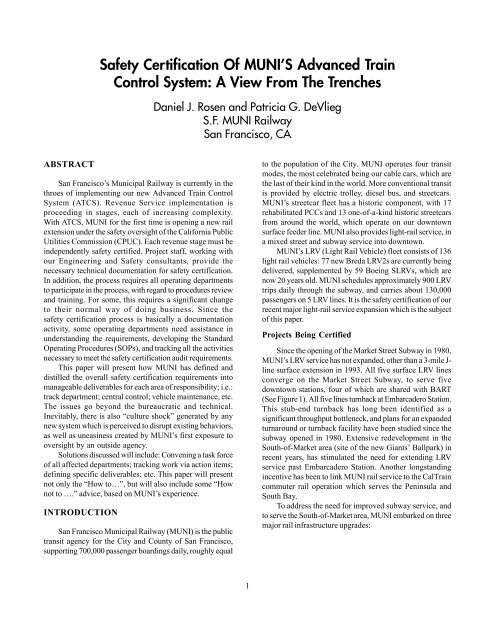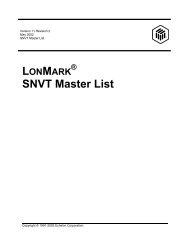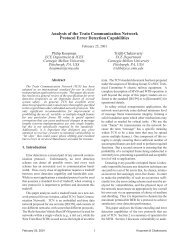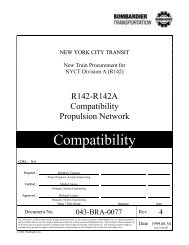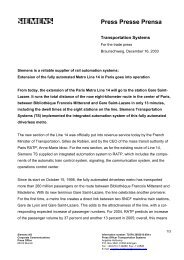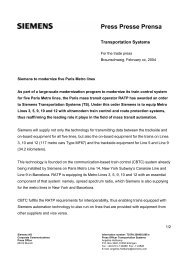Safety Certification Of MUNI'S Advanced Train Control ... - Tsd.org
Safety Certification Of MUNI'S Advanced Train Control ... - Tsd.org
Safety Certification Of MUNI'S Advanced Train Control ... - Tsd.org
Create successful ePaper yourself
Turn your PDF publications into a flip-book with our unique Google optimized e-Paper software.
ABSTRACT<br />
San Francisco’s Municipal Railway is currently in the<br />
throes of implementing our new <strong>Advanced</strong> <strong>Train</strong> <strong>Control</strong><br />
System (ATCS). Revenue Service implementation is<br />
proceeding in stages, each of increasing complexity.<br />
With ATCS, MUNI for the first time is opening a new rail<br />
extension under the safety oversight of the California Public<br />
Utilities Commission (CPUC). Each revenue stage must be<br />
independently safety certified. Project staff, working with<br />
our Engineering and <strong>Safety</strong> consultants, provide the<br />
necessary technical documentation for safety certification.<br />
In addition, the process requires all operating departments<br />
to participate in the process, with regard to procedures review<br />
and training. For some, this requires a significant change<br />
to their normal way of doing business. Since the<br />
safety certification process is basically a documentation<br />
activity, some operating departments need assistance in<br />
understanding the requirements, developing the Standard<br />
Operating Procedures (SOPs), and tracking all the activities<br />
necessary to meet the safety certification audit requirements.<br />
This paper will present how MUNI has defined and<br />
distilled the overall safety certification requirements into<br />
manageable deliverables for each area of responsibility; i.e.:<br />
track department; central control; vehicle maintenance, etc.<br />
The issues go beyond the bureaucratic and technical.<br />
Inevitably, there is also “culture shock” generated by any<br />
new system which is perceived to disrupt existing behaviors,<br />
as well as uneasiness created by MUNI’s first exposure to<br />
oversight by an outside agency.<br />
Solutions discussed will include: Convening a task force<br />
of all affected departments; tracking work via action items;<br />
defining specific deliverables; etc. This paper will present<br />
not only the “How to…”, but will also include some “How<br />
not to ….” advice, based on MUNI’s experience.<br />
INTRODUCTION<br />
<strong>Safety</strong> <strong>Certification</strong> <strong>Of</strong> MUNI’S <strong>Advanced</strong> <strong>Train</strong><br />
<strong>Control</strong> System: A View From The Trenches<br />
San Francisco Municipal Railway (MUNI) is the public<br />
transit agency for the City and County of San Francisco,<br />
supporting 700,000 passenger boardings daily, roughly equal<br />
Daniel J. Rosen and Patricia G. DeVlieg<br />
S.F. MUNI Railway<br />
San Francisco, CA<br />
1<br />
to the population of the City. MUNI operates four transit<br />
modes, the most celebrated being our cable cars, which are<br />
the last of their kind in the world. More conventional transit<br />
is provided by electric trolley, diesel bus, and streetcars.<br />
MUNI’s streetcar fleet has a historic component, with 17<br />
rehabilitated PCCs and 13 one-of-a-kind historic streetcars<br />
from around the world, which operate on our downtown<br />
surface feeder line. MUNI also provides light-rail service, in<br />
a mixed street and subway service into downtown.<br />
MUNI’s LRV (Light Rail Vehicle) fleet consists of 136<br />
light rail vehicles: 77 new Breda LRV2s are currently being<br />
delivered, supplemented by 59 Boeing SLRVs, which are<br />
now 20 years old. MUNI schedules approximately 900 LRV<br />
trips daily through the subway, and carries about 130,000<br />
passengers on 5 LRV lines. It is the safety certification of our<br />
recent major light-rail service expansion which is the subject<br />
of this paper.<br />
Projects Being Certified<br />
Since the opening of the Market Street Subway in 1980,<br />
MUNI’s LRV service has not expanded, other than a 3-mile Jline<br />
surface extension in 1993. All five surface LRV lines<br />
converge on the Market Street Subway, to serve five<br />
downtown stations, four of which are shared with BART<br />
(See Figure 1). All five lines turnback at Embarcadero Station.<br />
This stub-end turnback has long been identified as a<br />
significant throughput bottleneck, and plans for an expanded<br />
turnaround or turnback facility have been studied since the<br />
subway opened in 1980. Extensive redevelopment in the<br />
South-of-Market area (site of the new Giants’ Ballpark) in<br />
recent years, has stimulated the need for extending LRV<br />
service past Embarcadero Station. Another longstanding<br />
incentive has been to link MUNI rail service to the Cal<strong>Train</strong><br />
commuter rail operation which serves the Peninsula and<br />
South Bay.<br />
To address the need for improved subway service, and<br />
to serve the South-of-Market area, MUNI embarked on three<br />
major rail infrastructure upgrades:


